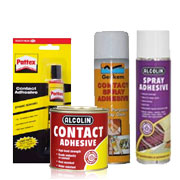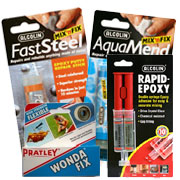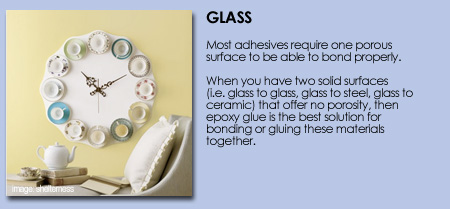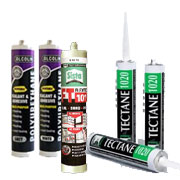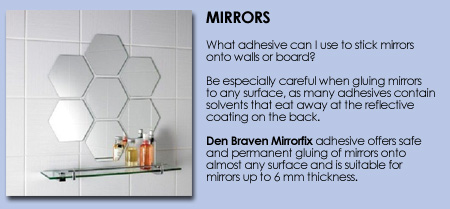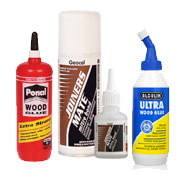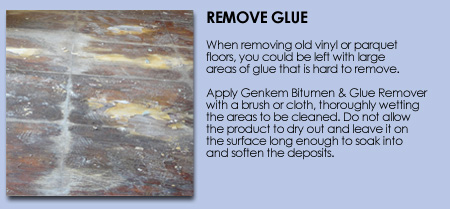Choosing the right adhesive is important for permanent sticking. Using the wrong adhesive can also damage or even destroy a project, so it helps to know what adhesives are available and what each type of adhesive is used for.

CONTACT ADHESIVE
Used in a wide variety of applications and on various materials, Contact Adhesive is a solvent-based adhesive that is spread over both faces of the material to be joined. Left to cure for approximately 5 minutes, the solvent evaporates until the adhesive is not tacky to touch, at which time the faces can be bonded together. It's a good idea to clamp thick materials when bonding with contact adhesive. Contact adhesive creates a strong bond when used to adhere melamine and Formica laminates.
Spray Contact Adhesive is fantastic. Spray on both surfaces to be joined, wait five minutes and place together. What could be quicker and easier! Use to secure fabric for headboards, spray onto paper and board to join, add new laminate to kitchen doors... and more! The product offers adhesion to – paper, coated paper, cardboard, canvas, stone, wood, coated wood, glass, most plastics, fiberglass, metals, fabric, foam, cork, leather, rubber and painted surfaces. However, will not adhere to some plastics, e.g. polyethylene, polypropylene, Teflon, plasticized PVC and is not suitable for use on expanded polystyrene

EPOXY GLUE
Epoxy glue normally comes in two tubes or pastes that are mixed or kneaded together to create an ultra-strong bonding. There are different varieties of epoxy glue, each variety suitable for specific materials, so check on the packet before you buy.
![]() GLASS - What adhesive can I use to glue glass to surfaces?
GLASS - What adhesive can I use to glue glass to surfaces?
Alcolin Rapid Epoxy is a 2-part, clear, fast-setting, polymer compound that mixes easily, enabling fast permanent repairs to many surfaces including fibreglass, concrete, glass, metals, wood, and some plastics.

POLYURETHANE (and other) ADHESIVES
Many adhesive manufacturers now offer a wide range of polyurethane, acrylic and silane adhesives, so many in fact that it can be confusing to know which one is the right one for a project.
Let's get 'stuck' in and take a look at the various adhesives available, and their uses:
ALCOLIN POLYURETHANE SEALANT & ADHESIVE is a polyurethane-based sealant that forms a strong permanently elastic bond to concrete, brick, wood, metal, steel, aluminium, granite, stone and PVC. It is fast curing, non-shrinking and can be easily smoothed. Ideal for bonding dissimilar or damp surfaces, or where gap-filling properties are required.
Excellent for sealing, bonding, waterproofing, insulating, roofing, flooring, decorative panels, carpentry, sanitary ware, fittings, etc.
Use for:
- Sealing floor and paving joints and low movement wall joints
- glazing and weather-sealing between door and window frames and plaster
- Laying parquet flooring
- Mounting of mirrors
- Sealing between building timber frames and masonry
- Bonding decorative panels, cladding and roof tiles
- Not suitable for underwater application
- Gaps exceeding 5mm in depth should be half filled with a backing foam before application
ALCOLIN MS37 is a new technology, high quality neutral curing adhesive and sealant in one. It remains elastic once cured and can be used for interior and exterior applications.
It provides several distinct advantages over traditional silicones. Unlike silicones, it is paintable and odourless. It provides excellent primerless adhesion to a much wider variety of substrates, including damp surfaces.
Performance is similar to a polyurethane sealant, with the advantage that it is isocyanate free, odourless and UV resistant.
Use for:
- Adheres to damp surfaces
- Paintable, odourless and elastic (allows movement) as well as gap filling and non-shrinking
- Excellent UV resistance and durability for outdoor applications
- Non-flammable and non toxic – contains no isocyanates
- Sealing between building carpentry and masonry, sealing of floor and paving joints and low movement wall joints, metal coverings, cracks in plaster, expansion and movement joints. Also, weather-sealing between door/window frames and plaster, laying of parquet floor tiles, mounting of mirrors, panels and insulation sheets and glazing
- Not recommended for professional applications, only for
DIY applications - May not bond to certain plastics and rubbers, test before use
- Does not adhere to polyethylene, polypropylene, Teflon, plasticized PVC and bituminous surfaces
- Not suitable for underwater application
- Not suitable for expansion joints greater than 25mm
![]() MIRRORS - What adhesive can I use to stick mirrors onto walls?
MIRRORS - What adhesive can I use to stick mirrors onto walls?
If you only need a quick fix solution for a small mirror here and there, grab a tube of Bostik Mirror. This product also states that it is ideal for mirror installations, bonding mirrors to painted surfaces, plaster, metal, or wood and is acid free – will not desilver or discolour mirrors.
DEN BRAVEN GLUE SCREWS is a versatile construction adhesive that cures by evaporation of solvents and forms a strong, durable, moisture resistant, lasting flexible bond.
Use for:
- Bonding of door frames, profiles and panels.
- For bonding chipboards and uPVC on brickwork, stone or concrete
- Suitable for polystyrene.
- Among others, not recommended for locations subject to continuous water emersion and not for PE, PP, Teflon and bituminous surfaces.
GENKEM POLYSTYRENE FOAM ADHESIVE is a synthetic rubber-based adhesive that can be used to bond polystyrene foam to itself and to almost all other clean and firm surfaces, e.g. metals, fibreglass, wood, etc. The product has excellent bond strength, good heat resistance and a high intial tack and may be applied by brush or spray application.
GENKEM ALL PURPOSE FLOORING ADHESIVE - water-based economical, acrylic adhesive with agressive grab. Clean and easy to work with and contains fungicide. Can be used for the installation of a wide variety of floor coverings onto concrete, screeded concrete and well-ventilated wooden strip flooring. Suitable for the laying onto well prepared surfaces, floor coverings such as needlepunch carpets, foam and vinyl backed carpets, as well as for most types of carpet tiles and semi-flexible vinyl.

WOOD GLUE
As the name implies, wood glue is used primarily for joining wood or board products together. Depending on the nature of your project you will need to use either an interior or exterior wood glue. Apply a thin bead of wood glue along one bonding edge and clamp together until the glue has set.
Wipe away any excess glue before it has time to dry.

HOW TO REMOVE CONTACT ADHESIVE OR BITUMEN GLUE
GENKEM BITUMEN & GLUE REMOVER is a highly concentrated blend of aromatic stripping solvents and emulsifier for the effective removal of bitumen, contact adhesives and other glues. Cleans tar splashes from motor vehicles and works as an effective stripper for many varnishes and sealers. Can also be used for cleaning floors, e.g. cement or wooden floors where tiles have been stuck down with bitumen or tiled floors where carpets have been stuck down with contact or latex adhesives.
![]() OLD GLUE - How do I remove glue from floors?
OLD GLUE - How do I remove glue from floors?

